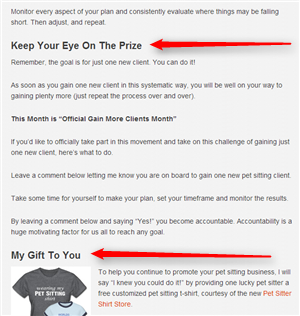SEO (Search Engine Optimization) is about all the ways you can improve your website to…
How to Create The Perfect Blog Post in 8 Steps [Checklist]
 It’s amazing to see so many pet sitters beginning to understand the value of writing plenty of content on their websites.
It’s amazing to see so many pet sitters beginning to understand the value of writing plenty of content on their websites.
If you do not like writing, it may become a necessary evil that you’ll have to come to terms with, as more and more of your potential clients will hop online to search for your service.
A pet owner will pull up Google, type in an appropriate search term, and what websites are going to be shown near the top of that first page?
The websites that Google has discovered to be relevant and informative to the search users query. This no longer happens by simply placing a set of keywords somewhere on the page or in the meta tags.
While you still need to consider those SEO actions, you will be left behind if you do not begin to understand the value of content creation (also known as blogging or writing articles).
Don’t believe me? Then take it from Google themselves:
“Give visitors the information they’re looking for.
Provide high-quality content on your pages, especially your homepage. This is the single most important thing to do. If your pages contain useful information, their content will attract many visitors and entice webmasters to link to your site. In creating a helpful, information-rich site, write pages that clearly and accurately describe your topic. Think about the words users would type to find your pages and include those words on your site.”
Source: Google Friendly Sites – https://support.google.com/webmasters/answer/40349?hl=en&ref_topic=2370419
Did you catch that? Google says creating high-quality content is “the single most important thing to do.” Who can argue that?
SIDE NOTE: You can learn more by becoming a member of PetSittingOlogy and Get Found First with our SEO-driven website for pet professionals!
Creating The Perfect Blog Post Checklist
If you want to make the most positive impact with your blog posts, make sure you include these 8 things into every one of your articles.
#1 – Great headline.
Also referred to as the title of your blog post, your blog post headline is perhaps the most important element of your entire effort. Here are two reasons why:
1) Your headline is used to get the click in the search results. It becomes the big blue link that Google displays for users to click on.

2) In order to achieve that, your headline needs to get the reader curious and interested in reading the article that they decide to click through to your website.
Ideally, it should contain a “promise”, something the reader will specifically gain from spending their time digesting your content.
Consider these two headline examples, not from an SEO (keyword) perspective, but from a ‘human’ perspective. Which headline drums up more of your interest? And which one are you more likely to click on if you saw it in the search results.
A) Best Dog Parks in Cleveland To Take Your Dog
B) 6 Friendly Dog Parks in Cleveland Where Spot Can Play, Socialize, and Exercise
They both contain the key phrase ‘dog parks in Cleveland’ but isn’t choice B more interesting to see in the search results?
Tip: It’s sometimes easier to create the headline after you have outlined or written the article.
#2 – A strong image near the top.
We are all visual creatures. We like and need things to look at. Simply having paragraphs of text on your page will cause strain on the eyes and will quickly turn off the reader.
Place a good looking image near the beginning of your blog post for maximum impact.
You can place your image to the left or right side of your first paragraph and have the text wrap around it, or you can place one big attention-grabbing image above your first paragraph.

And here’s the best part: The image you choose does not necessarily need to be an exact depiction of your topic. In other words, if you are writing about dog parks, you do not always need an image of a dog park.
If the tone and underlying subject of the post is about exercise or bonding or play or longevity, any relevant or abstract image can work just as well.
Look back through the blog articles on this very site, and you will see how I do the same.
Bonus: Here are a few of my favorite resources for free blog images to use:
#3 – At least 300 words of text.
There is no true rule of thumb here, but you do want to keep a few things in mind when creating your post.
A) 300 words should be a good minimum but you should also create much lengthier articles. Google wants to see a variety of word counts between your articles. At the end of the day, your post should contain just as many words as it takes to get your point fully across.
B) Break paragraphs up to just a few sentences. This makes it very easy for your reader to scan and digest your words. If you look through my blog posts here you will see small paragraphs and even one sentence paragraphs.
#4 – Insert creative sub-headlines.
It’s important to break up your paragraphs with secondary headlines, or sub-heads, for the reader’s benefit. This will allow her to scan and get a feel for what the next section is about.
After you write your blog post, go back and see how you can “chunk” a few paragrpahs together and then create a sub-headline to preface the next set of paragraphs.
Use the same strategy for sub-headlines as you do for the main headline. (Make sure it’s relevant, catchy, and tells the reader what’s in store.)

#5 – Change it up with video.
We all like variety in life, don’t we? Google is no different, and your readers are no different.
Consider mixing up the blocks of content with a relevant video inserted in your post.
The best news is that it need not even be a video you shot.
Search Google to find interesting and relevant videos and add them to your blog post to further support your content and theme.
You can embed a Youtube video that you shot, or search for a popular one that compliments what is on your page. In essence, you are providing more tools and resources to your page.
#6 – Call to Action.
I speak a lot about the importance of placing a call to action near the bottom of your website pages (IE. services page, about, fees, etc) to entice your potential client to make contact with you.
Your blog posts are no different. Interaction is one way to gauge how effective your voice is. Plus, it helps to know that you are not simply talking to the air!
Typically, you’ll want the reader to comment and participate in the dialogue, right?
End each post with a few sentences that ask the reader for their thoughts, input, or opinion. And ask them to share it.
Using the dog parks article as an example, you might end it with something like:
“Over to you, please! Let us know in the comments below how often you take your dog to the park. Has your pooch made some lifelong playmates this way? Any other dog park tips or tricks you care to share that we can include?”
You’ll notice I do this with each of the posts on this site.
#7 – Social Media Share Buttons.
Make sure to include a few of the popular share buttons on each blog post. This will encourage viral engagement with your website.
Not only does that help spread the word, but Google ‘rewards’ web pages that are shared via social media.
There are some specific nuances to the way this works but, these days, Google can tell the relevancy and popularity of a web page article based on number of shares, likes, tweets, etc.
Do not overwhelm your users with a dozen different options of places to share.
Simply provide a few of the most common ones that make sense for you and your ideal audience. If you look at the top of every post on this site, you’ll see our few share buttons waiting to be used.
#8 – Most Popular Posts list.
A short list of the most popular posts (or related posts) near the bottom of your article is a good idea. It gives the reader more options if they want to consume more of your insight.
This is also another reason to create incredible headlines (titles) since they will populate in the popular post lists.
Over to You!
So, where do you fit in the blogging/writing content world? Do you love it, hate it, struggle with it? Or have you seen the pay off first hand from your blogging efforts? Chat with us in the comments below.
This happens to be one of my favorite topics that I am most passionate about (content, blogging). Let me know what you are currently working through?
This Post Has 6 Comments
Comments are closed.




Excellent information Josh. Writing a blog does not have to be complicated.
You are correct, Anthony. I always say that the biggest challenge is getting started. Once you put pen to paper and just start writing, you will see how easy it all comes together.
The Perfect Checklist! Thank you for putting this together I especially love the links for Free Images to use, that is something I struggle with.
Thanks Joanne! I appreciate the comment.
Love this! Thanks Josh! It is harder to start easier in the middle and for me harder to figure out how to end – oh well!
Just like anything else, the more you do it, the more comfortable you get with it. And the easier it becomes. This is a learned skill like anything else and we all have the ability to communicate in this form.